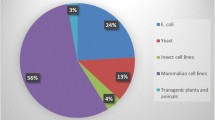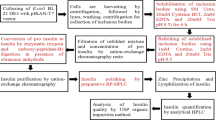Abstract
Efficient recombinant expression of N-acyl-l-aminoacylase 1 from pig kidney (pAcy1) was achieved in the prokaryotic host Escherichia coli. An optimized nucleotide sequence (codon adaptation index 0.95 for E. coli), was cloned into vector pET-52(b) yielding an E. coli-expressible pAcy1 gene. Formation of inclusion bodies was alleviated by co-expression of molecular chaperones resulting in 2.7- and 4.2-fold increased recovery of active pAcy1 using trigger factor or GroEL–GroES, respectively. Facile purification was achieved via StrepTag affinity chromatography. Overall, more than 80 mg highly active pAcy1 (94 U/mg) was obtained per liter of cultivation broth. The protein was analyzed for structural and functional identity, and the performances of further described expression and purification systems for pAcy1 were compared.







Similar content being viewed by others
References
Baneyx F (1999) Recombinant protein expression in Escherichia coli. Curr Opin Biotechnol 10:411–421
Birnbaum SM, Levintow L, Kingsley RB, Greenstein JP (1952) Specificity of amino acid acylases. J Biol Chem 194:455–470
Bommarius AS, Drauz K, Klenk H, Wandrey C (1992) Operational stability of enzymes. Acylase-catalyzed resolution of N-acetyl amino acids to enantiomerically pure l-amino acids. Ann N Y Acad Sci 672:126–136
Bornscheuer UT, Pohl M (2001) Improved biocatalysts by directed evolution and rational protein design. Curr Opin Chem Biol 5:137–143
Chung CT, Niemela SL, Miller RH (1989) One-step preparation of competent Escherichia coli: transformation and storage of bacterial cells in the same solution. Proc Natl Acad Sci U. S. A 86:2175–2172
Dean KES, Klein GR, Renaudet O, Reymond J-L (2003) A green fluorescent chemosensor for amino acids provides a versatile high-throughput screening (HTS) assay for proteases. Bioorg Med Chem Lett 13:1653–1656
Durand A, Giardina T, Villard C, Roussel A, Puigserver A, Perrier J (2003) Rat kidney acylase I: further characterisation and mutation studies on the involvement of Glu 147 in the catalytic process. Biochimie 85:953–962
Fuhrmann M, Hausherr A, Ferbitz L, Schödl T, Heitzer M, Hegemann P (2004) Monitoring dynamic expression of nuclear genes in Chlamydomonas reinhardtii by using a synthetic luciferase reporter gene. Plant Mol Biol 55:869–881
Gentzen I, Löffler HG, Schneider F (1980) Aminoacylase from Aspergillus oryzae. Comparison with the pig kidney enzyme. Z Naturf Sect C: Biosciences 35:544–550
Jana S, Deb JK (2005) Strategies for efficient production of heterologous proteins in Escherichia coli. Appl Microbiol Biotechnol 67:289–298
Kandror O, Sherman M, Rhode M, Goldberg AL (1995) Trigger factor is involved in GroEL-dependent protein degradation in Escherichia coli and promotes binding of GroEL to unfolded proteins. EMBO J 14:6021–6027
Kördel W, Schneider F (1976) Chemical investigations on pig kidney aminoacylase. Biochim Biophys Acta 445:446–457
Laemmli UK (1970) Cleavage of structural proteins during the assembly of the head of bacteriophage T4. Nature 227:680–685
Liu Z, Zhen Z, Zuo Z, Wu Y, Liu A, Yi Q, Li W (2006) Probing the catalytic center of porcine aminoacylase 1 by site-directed mutagenesis, homology modeling and substrate docking. J Biochem 139:421–430
Lugay JC, Aronson JN (1969) Palo Verde (Parkinsonia aculeata L.) seed aminoacylase. Biochim Biophys Acta 191:397–414
Maier T, Drapal N, Thanbichler M, Böck A (1998) Strep-tag II affinity purification: an approach to study intermediates of metalloenzyme biosynthesis. Anal Biochem 259:68–73
Makrides SC (1996) Strategies for achieving high-level expression of genes in Escherichia coli. Microbiol Rev 60:512–538
Mitta M, Ohnogi H, Yamamoto A, Kato I, Sakiyama F, Tsunasawa S (1992) The primary structure of porcine aminoacylase 1 deduced from cDNA sequence. J Biochem 112:737–742
Mitta M, Kato I, Tsunasawa S (1993) The nucleotide sequence of human aminoacylase-1. Biochim Biophys Acta 1174:201–203
Nishihara K, Kanemori M, Kitagawa M, Yanagi H, Yura T (1998) Chaperone coexpression plasmids: differential and synergistic roles of DnaK-DnaJ-GrpE and GroEL-GroES in assisting folding of an allergen of Japanese cedar pollen, Cryj2, in Escherichia coli. Appl Environ Microbiol 64:1694–1699
Novy R (2001) Overcoming the codon bias of E. coli for enhanced protein expression. Newsletter of Novagen:1–3
Palm GJ, Röhm KH (1995) Aminoacylase I from porcine kidney: identification and characterization of two major protein domains. J Protein Chem 14:233–240
Parker KC, Garrels JI, Hines W, Butler EM, McKee AH, Patterson D, Martin S (1998) Identification of yeast proteins from two-dimensional gels: working out spot cross-contamination. Electrophoresis 19:1920–1932
Perkins DN, Pappin DJ, Creasy DM, Cottrell JS (1999) Probability-based protein identification by searching sequence databases using mass spectrometry data. Electrophoresis 20:3551–3567
Pittelkow S, Lindner H, Röhm K-H (1998) Human and porcine aminoacylase I overproduced in a baculovirus expression vector system: evidence for structural and functional identity with enzymes isolated from kidney. Protein Expr Purif 12:269–276
Sakanyan V, Desmarez L, Legrain C, Charlier D, Mett I, Kochikyan A, Savchenko A, Boyen A, Falmagne P, Pierard A (1993) Gene cloning, sequence analysis, purification, and characterization of a thermostable aminoacylase from Bacillus stearothermophilus. Appl Environ Microbiol 59:3878–3888
Sambrook J, Russel DW (2001) Molecular cloning: a laboratory manual. Cold Spring Harbor Laboratory Press.
Sato T, Tosa T (1993) Optical resolution of racemic amino acids by aminoacylase. Bioproc Technol 16:3–14
Sharp PM, Li WH (1987) The codon Adaptation Index—a measure of directional synonymous codon usage bias, and its potential applications. Nucleic Acids Res 15:1281–1295
Wada E, Handa M, Imamura K, Sakiyama T, Adachi S, Matsuno R, Nakanishi K (2002) Enzymatic synthesis of N-acyl-l -amino acids in a glycerol–water system using acylase I from pig kidney. J Am Oil Chem Soc 79:41–46
Wang HR, Zhang T, Wang ZF, Wang XC, Zhou HM (1995) Aminoacylase from pig kidney contains no disulfide bonds. Sci China Ser B 38:1454–1448
Wu G, Bashir-Bello N, Freeland SJ (2006) The Synthetic Gene Designer: a flexible web platform to explore sequence manipulation for heterologous expression. Protein Expr Purif 47:441–445
Yang JT, Wu CS, Martinez HM (1986) Calculation of protein conformation from circular dichroism. Methods Enzymol 130:208–269
Yang Y, Wang HR, Zhou HM (1996) Kinetics of inhibition of aminoacylase activity by dithiothreitol or 2-mercaptoethanol. Int J Pept Prot Res 48:532–538
Yoshimune K, Ninomiya Y, Wakayama M, Moriguchi M (2004) Molecular chaperones facilitate the soluble expression of N-acyl-d-amino acid amidohydrolases in Escherichia coli. J Ind Microbiol Biotechnol 31:421–426
Youshko MI, van Rantwijk F, Sheldon RA (2001) Enantioselective acylation of chiral amines catalysed by aminoacylase I. Tetrahedron: Asymmetry 12:3267–3271
Acknowledgements
We thank Dr. A. Krager (Friedrich-Loeffler-Institute, Insel Riems, Germany) for mass spectroscopy analysis, F. Leipold for support in CD spectroscopy and the “Fachagentur für Nachwachsende Rohstoffe” (FNR, Gülzow, Germany, Grant No. 22009405) for financial support.
Author information
Authors and Affiliations
Corresponding author
Rights and permissions
About this article
Cite this article
Wardenga, R., Hollmann, F., Thum, O. et al. Functional expression of porcine aminoacylase 1 in E. coli using a codon optimized synthetic gene and molecular chaperones. Appl Microbiol Biotechnol 81, 721–729 (2008). https://doi.org/10.1007/s00253-008-1716-7
Received:
Revised:
Accepted:
Published:
Issue Date:
DOI: https://doi.org/10.1007/s00253-008-1716-7




